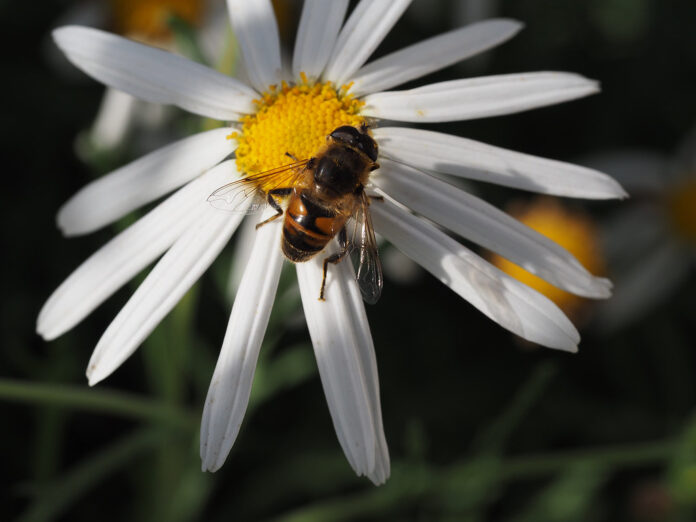Honey Bees versus Native Bees: Perth’s Urban Pollinator Puzzle
Perth’s urban bushlands and garden corridors, long celebrated for their unique biodiversity, are now grappling with a challenge that strikes at the heart of local conservation. A groundbreaking study led by Dr Kit Prendergast at Curtin University’s School of Molecular and Life Sciences reveals that invasive European honey bees are not the benign visitors many have assumed. Instead, they appear to be undermining the vitality of Western Australia’s native, cavity‐nesting bees—a finding that has significant implications for local ecosystems already under pressure from urban growth.
A Closer Look at the Competition
In an innovative two‐season investigation stretching from spring to summer across 14 urban bushland and garden sites in Perth, Dr Prendergast and her team employed specially designed wooden “bee hotels.” These structures, more than nesting sites for thirsty pollinators, became indispensable research tools, allowing the team to assess differences in reproductive success and overall health between native bees coexisting with dense honey bee populations and those in less competitive environments.
The results are sobering. In regions where honey bee densities were higher, native bees showed several signs of reduced fitness. The study noted fewer female offspring emerging from nests, a stark finding given that female bees are crucial for sustaining populations—they not only continue the species but also play vital roles in pollination. Male offspring, on the other hand, were smaller and displayed higher mortality rates. Such subtle yet critical impacts on bee fitness suggest that honey bees, despite their importance in managed pollination and honey production, may inadvertently be throttling the very diversity needed to keep local ecosystems resilient.
Urban Landscapes and Native Bee Decline
Urbanisation across Perth has long been a double-edged sword. On one hand, modern development and expanding suburbs have brought economic opportunities and a bustling city life; on the other, they have sharply curtailed the natural habitats that native species rely on. Native bees in Western Australia, many of which are specialised to local flora, are already vulnerable to habitat fragmentation, loss of nesting sites, and the encroachment of exotic plant species. The study highlights that honey bees often forage on a wider range of pollen sources, including exotic plants. This flexible feeding behaviour gives honey bees a competitive edge, particularly when native floral resources diminish due to urban development or the encroachment of invasive species.
In certain locations, it appears that extensive overlap in pollen use between honey bees and native bees is likely creating intense competition. As native bees struggle to secure the nutrients essential for developing robust, viable offspring, their populations—already fragile in a rapidly changing landscape—face further decline. The implications for biodiversity are clear: if native bees continue to lose ground, the broader health of local ecosystems may be compromised, given the critical role that these pollinators play in maintaining plant reproduction and ecosystem stability.
Bee Hotels: A Dual Role
The use of bee hotels in this research speaks to an emerging strategy in urban conservation. Initially created to offer shelter to native bee species, these structures have now evolved into effective scientific instruments. They provide researchers with controlled settings to monitor changes in bee reproduction and survival over time. By tracking over 1,000 native bee nests spanning at least 25 different species, the study by Curtin University has assembled a comprehensive picture of how honey bee overabundance may be skewing the delicate balance of native pollinator communities.
Beyond their immediate research utility, bee hotels have become emblematic of broader community initiatives in Western Australia. Projects such as ReWild Western Australia and native garden schemes have often championed the installation of bee hotels as part of efforts to reconnect urban dwellers with the local environment. However, as Dr Prendergast’s research demonstrates, the mere provision of nesting sites may not be enough. Conservation measures must also consider the dynamic interactions among species—in this case, a well-intentioned increase in bee numbers could simply result in a surge of honey bee populations that, in turn, impact native species.
Lessons from Elsewhere
Dr Prendergast’s findings in Perth echo concerns from studies conducted overseas. In parts of Europe, for instance, research has linked high densities of managed honey bee hives to significant declines in wild pollinator diversity, with some studies suggesting reductions of up to 50% in areas affected by aggressive honey bee foraging. Similarly, in the United States, national parks have increasingly scrutinised the placement of commercial hives after observing adverse impacts on local bee populations.
These international experiences offer cautionary lessons for Western Australia. While managed honey bees play a pivotal role in agriculture and food production, their proliferation—especially when left unchecked in urban areas rich in vulnerable native species—calls for a careful and nuanced approach. For Perth, where urban growth is inseparable from environmental stewardship, embracing these lessons could prove vital in maintaining the region’s ecological heritage.
Policy Implications and Local Action
The implications of this research extend well beyond the realm of academic inquiry. Currently, Western Australia does not have statewide regulations governing the placement or density of honey bee hives in proximity to conservation areas. In many urban settings, including inner-city suburbs and even parts of recently developed areas, many hobbyist and commercial beekeepers have been welcoming the trend towards local honey production—a surge that accelerated notably during the COVID-19 pandemic.
Local government bodies, such as the City of Stirling—which helped fund Dr Prendergast’s study—are increasingly aware of the need to balance urban beekeeping with the conservation of native pollinators. While some councils have established limits on the number of hives per property, enforcement and broader regional strategies remain limited. Experts such as Dr Prendergast are calling for more proactive measures, including the creation of “honeybee-free zones” around key green spaces and conservation reserves. The adoption of such measures may help to minimise the competitive pressures on native bees in these critical ecosystems.
In addition, there is growing recognition that enhancing the diversity of flowering plants could provide native bees with a more competitive edge. By planting a wide range of indigenous flora that support native pollinators—plants which may be less attractive to honey bees—local governments and community groups could help to level the playing field. This strategy finds parallels in initiatives across other Australian states, such as the “Save Our Native Bees” campaign in New South Wales, which has seen proposals to reduce the number of managed hives in protected areas.
Historical Context and Future Directions
Western Australia has a storied history of innovative approaches to environmental management. Past projects—from the restoration of Banksia woodlands to community-led urban greening initiatives—have underscored the importance of preserving native biodiversity in the face of expanding urbanisation. The current research fits neatly into this larger narrative, serving as both a warning and a call to action.
The study’s emphasis on fitness indicators—such as the ratio of male to female offspring, offspring mortality, and overall size—provides a granular understanding of how competition with honey bees might be quietly reshaping the lives of native species. The ripple effects could extend well beyond bee populations. As native bees decline, the plants they pollinate may experience reduced reproductive success, potentially triggering a cascade of ecological consequences in urban bushlands.
Looking ahead, Dr Prendergast advocates for further investigations that might explore whether adjusting honey bee numbers or strategically increasing the diversity and abundance of native flowering plants could mitigate some of the negative effects observed. Such research could help to refine conservation strategies and inform policy debates, ensuring that both agricultural interests and biodiversity conservation efforts are advanced in tandem.
A Delicate Balance for Perth’s Future
The polycentric challenges facing Perth—and indeed much of Western Australia—require a multifaceted response. As urban development rapidly encroaches on bushlands, the pressures on native wildlife intensify. The discovery that invasive honey bees, often celebrated as symbols of productivity and efficiency, may inadvertently be undermining native pollinator fitness, forces a re-evaluation of current practices.
It is a reminder that conservation in an urban context is rarely straightforward. Enhancing one aspect of the ecosystem can have unforeseen consequences on another. In this instance, increasing opportunities for bees through well-meaning measures like bee hotels must be paired with a thoughtful consideration of species interactions. The findings highlighted by Dr Prendergast’s research demonstrate that even well-intended management practices require constant reassessment, especially as environmental conditions change.
While the study raises challenges, it also paves the way for innovative solutions. Concerted efforts to monitor, manage, and balance bee populations could serve as a model for other regions facing similar issues. Engaging local communities, regulatory bodies, and researchers in ongoing dialogue about pollinator health may ultimately help to secure a more sustainable future for Perth’s rich natural heritage.
A Story of Urgency and Opportunity
For Perth residents, the emerging narrative of competition between honey bees and native bees is not just an academic concern—it is a call for urgent local action. As the city continues to expand, preserving the integrity of urban bushlands becomes more crucial than ever. Local initiatives that encourage the planting of indigenous flora, the creation of protected green zones, and thoughtful regulation of managed honey bee populations will be essential to safeguarding the native pollinator communities on which local ecosystems depend.
At its core, Dr Prendergast’s study is a vivid illustration of how introduced species can disrupt longstanding ecological relationships. The careful experimentation using bee hotels across Perth’s diverse urban landscapes underscores the fragility of native populations in the face of new pressures. However, it also highlights the resilience of local scientific inquiry and community engagement. With continued research and informed policy measures, Perth has the opportunity to develop strategies that not only balance the economic and cultural importance of honey bees but also ensure that native bees continue to thrive.
As Perth charts its course towards a greener future, the interplay between urban development, agriculture, and biodiversity conservation will remain a defining issue. The nuanced insights provided by this study should spur both policymakers and community advocates to re-examine current practices and invest in forward-thinking solutions—a task that is as complex as it is vital for the health of Western Australia’s natural environment.
Sources and Further Reading:
• Frontiers in Bee Science – “Introduced honey bees have the potential to reduce fitness of cavity-nesting native bees in terms of a male bias sex ratio, brood mortality and reduced reproduction” (DOI: 10.3389/frbee.2025.1508958)
• City of Stirling Environmental Publications
• Reports from the WA Planning Commission and Department of Biodiversity, Conservation and Attractions
• International studies on pollinator dynamics in Europe and the United States
In balancing tradition with innovation, Perth—and indeed all of Western Australia—faces a defining challenge. The survival of native bees, and by extension healthy urban ecosystems, hinges on our ability to understand and mediate the sometimes unforeseen consequences of human interventions in nature.

